Does Car Wax Remove Scratches?
Scratches in their car's paint are a problem that virtually all car owners will have at one time or another.
Many owners wonder as they look at their local hardware store's vast selection of automotive paint care products: "Does Car Wax Remove Scratches?".
No, car wax won't remove most scratches on a car's paint. However, it may decrease the visibility of fine scratches. Car wax's purpose is to protect your car's paint from harmful UV rays, oxidation, and particles such as road salt and improve its paint appearance. Car polish is formulated to remove scratches.
Below we go over some details on car wax and some products and techniques that will work to remove scratches from a car.
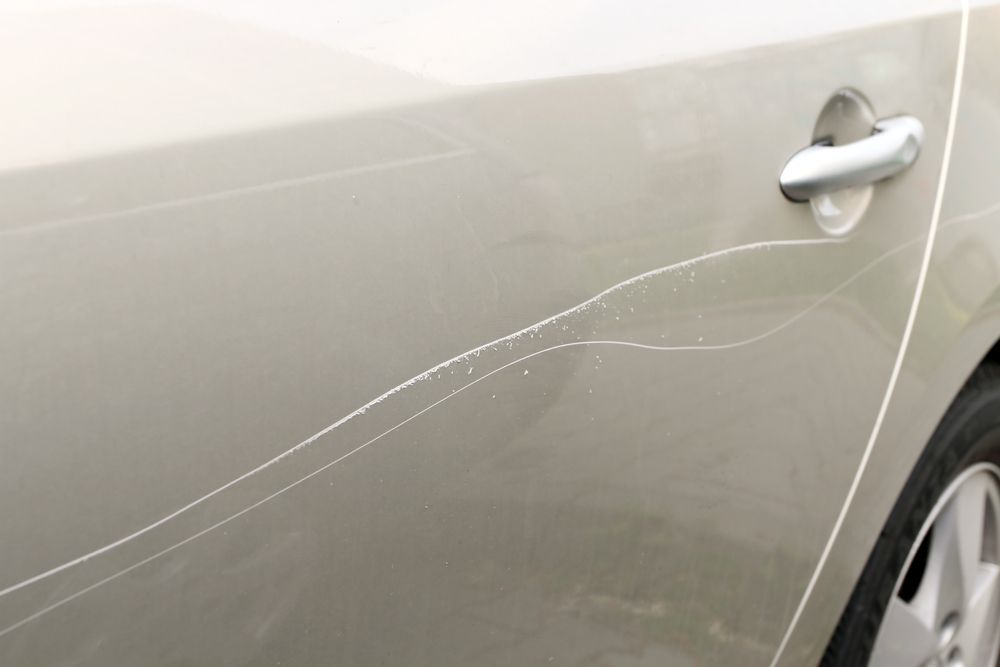 Deep scratch along side of car
Deep scratch along side of car
What Does Waxing a Car Do?
Simply speaking, modern cars are painted in three steps.
First, primer is applied to the bare metal. The primary purpose of primer is to provide a smooth surface to which the base color coat can be applied.
Second, the base color coat, the car's actual paint color, is applied on top of the primer.
Finally, a clear coat is applied on top of the color coat. A clear coat gives the car a shiny appearance. In addition, it protects the color coat from UV rays, oxidation, and harmful contaminants like dirt and pollutants in the rain.
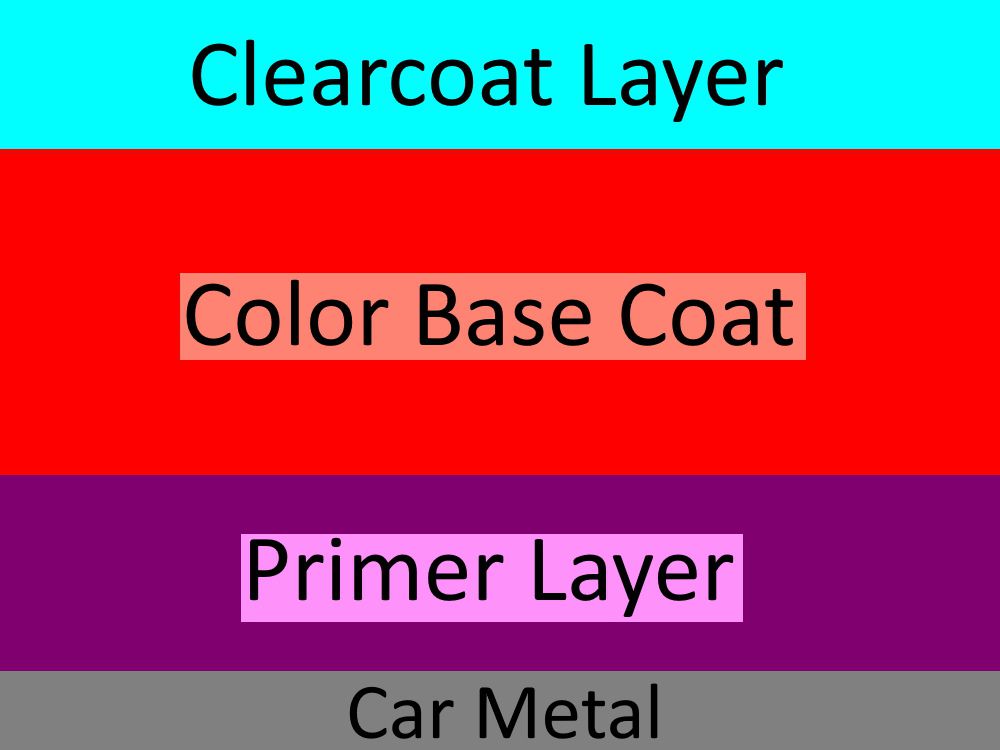 Layers of paint on a car
Layers of paint on a car
Waxing a car will add another layer of protection to your car's paint by adding a protective layer on top of the clear coat layer.
The wax saves you time and money in the long run because it is much easier to wax than to repair a damaged clear coat. It also increases your vehicle's resale by keeping it looking new!
Does Wax Stop Scratches?
Car wax may prevent some very light scratches from occurring but will not prevent the majority of cases.
However, the wax will make scratch removal easier by maintaining the clear coat, giving the auto detailer more material to polish.
What Removes a Scratch from a Car?
Abrasives like sandpaper, car polish, and even toothpaste can remove scratches from a car.
Abrasives work by removing and/or blending material from the on and around the scratched paint, effectively blending it with the paint around it.
Will Car Polish Remove Scratches?
You can use car polish or fine-grained sandpaper for lighter scratches in the clear coat layer.
These scratches (which tend to go deeper than blemishes) are relatively easy to repair, even for a newbie.
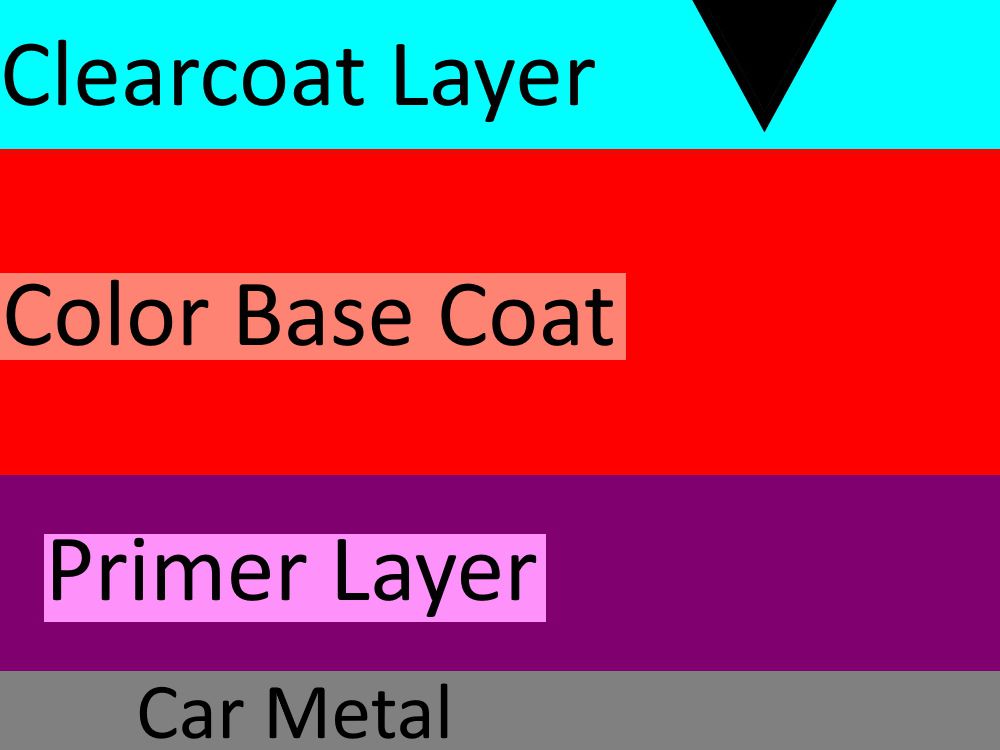 A shallow scratch only goes into the clearcoat layer.
A shallow scratch only goes into the clearcoat layer.
Aside from buffing out the surface-level scratches, though, using car wax also runs the risk of rubbing off wax.
Check out the following factors to determine if a scratch or blemish is surface-level enough to buff out with a polishing compound:
Does your fingernail catch on the scratch?
Does the reflection of light in the scratch appear white-colored?
Does light catch in the side of the scratch/groove?
When answering yes to these questions, you probably have a scratch that is minor enough to polish out.
If the scratch goes deeper and shows signs of oxidation (rusting), you'll want to switch to a more abrasive scratch remover.
But if the scratch is shallower and consists mainly of a visual imperfection, there are ways to blend out the appearance with waxes and other substances.
Will Sandpaper Remove Scratches?
You will need to use sandpaper for scratches into the car's color coat.
Repairing scratches into the car's color coat requires care because you don't want to remove the paint down to the primer.
You can tell if you need to use sandpaper if your fingernail catches in the scratch and can dig deeper.
You'll also likely notice that the scratch doesn't reflect light as easily as a surface-level scratch since the clear coat has been wiped out on that spot.
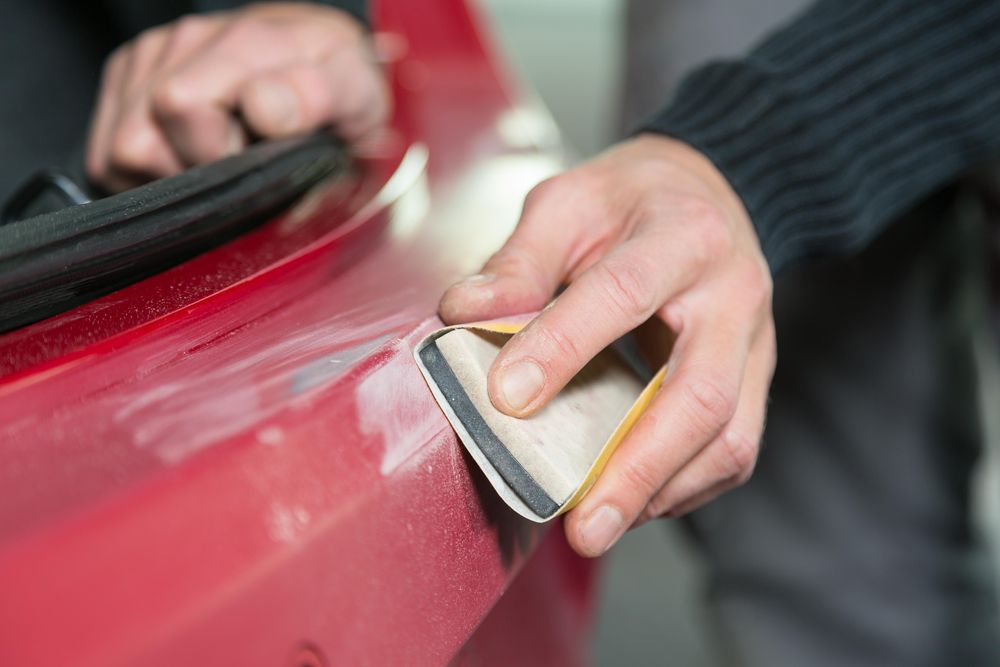 Using sandpaper to remove a scratch in a car's paint.
Using sandpaper to remove a scratch in a car's paint.
Some people do a “wet sanding,” but only if the scratch is shallow enough that you can't see the car's metal.
Otherwise, use 3,000 or 5,000 grit sandpaper on the isolated area of the scratch, moving up-down against the grain until the scratch disappears.
After this, you can sand in a circular motion to blend.
The benefit to removing car scratches with sandpaper is mainly in the cost-effectiveness.
However, it can be a little challenging to get an even sanding job done with your hands, and it may lead to frustration as you try to buff out a scratch without ruining the surrounding surface of the car.
Toothpaste to Remove Scratches on your Car?
You can even use toothpaste to buff out scratches on a vehicle, but only if the scratch is a minor paint scratch.
This method won't work on deep scratches or those that reach down to the metal.
Remember that this requires using traditional toothpaste (not gel-style).
Colgate says toothpaste is slightly abrasive due to its silica and chalk ingredient content.
When you gently rub this over a surface-level scratch or scratch on the clear coat, it can buff the clear coat until it's more even.
This lowers the visibility of the scratch.
Here's how to use toothpaste to remove scratches on your car:
First, clean and dry the area on and around the scratch to remove dirt, paint, and debris
Get a bit of toothpaste about as big as a pea
Put the toothpaste on a soft rag or cloth (make sure the cloth is completely dry first)
Use the cloth to rub the toothpaste over the scratch in gentle, evenly pressured circles
Once the car's surface appears smooth and scratch-free again, you can wipe away the toothpaste residue and clean it.
Other Methods to Remove Scratches
Aside from using mild abrasives like toothpaste, sandpaper, and car polishing compounds, you can also buff out or disguise certain scratches with wax and other products designed for removing scratches.
Many prefer polish and polishing compounds to wax since they can buff out imperfections instead of just masking them.
Products with foam applicators, sponges, or even motorized applicators that spin a soft disc are great choices.
Candle Wax
Candle wax may seem like a bizarre choice, and you should note that it doesn't actually fix a scratch but instead covers it up.
It's a temporary fix until you get a scratch on the surface (clear coat) buffed out.
You simply rub candle wax (preferably a white or plain candle) against the scratch and let it fill in the blemish to make it appear smooth and less noticeable.
You want to avoid using wax candles with heavy perfumes, chemicals, and other additives since you don't know how these substances might interact with your car's paint or the metal beneath the paint.
Car Scratch Remover Pen
There are even products designed to fix car scratches in a pinch, like scratch-removal pens.
But they're only effective on clear coat scratches and won't fix blemishes extending through to the paint layer or metal of your vehicle.
Can WD 40 Remove Car Scratches
WD 40 is a lubricant (oil-based) product for machinery and thus is not the best choice for removing car scratches.
The lubricant doesn't usually damage vehicle paint, but it also won't buff scratches out of the paint layer on your car.
It's better in a pinch if your car's top coat has a scuff or small blemish.
It works similarly to candle wax in that it doesn't fix a scratch; rather, it disguises the scratch by blending into the clear coat.
How To Repair Scratches That Go Into The Primer?
Deeper scratches on cars that go past the clear coat and chip the paint need a different remedy.
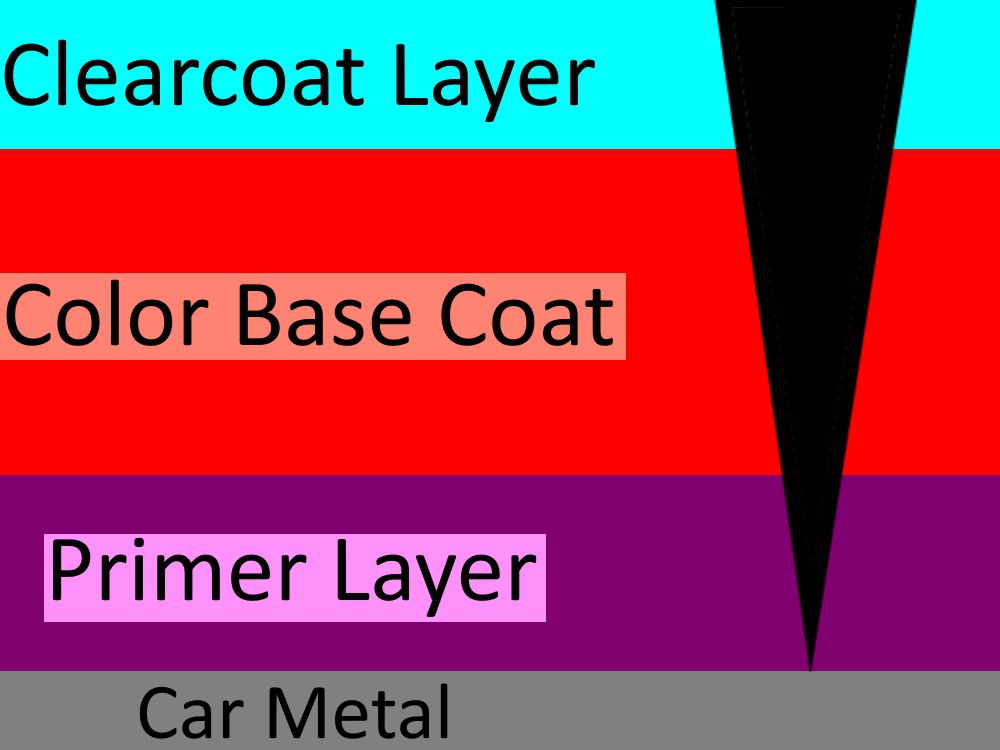 A deep scratch goes through the clearcoat, color base, and primer layer.
A deep scratch goes through the clearcoat, color base, and primer layer.
If they aren't properly repaired, they can cause rust issues.
You must start by thoroughly cleaning the scratch with soapy water to remove paint residue, car wax, and debris.
Once you've washed, dry with a lint-free cloth to avoid leaving fibers behind.
If there are already signs of rust, you need to use a rust remover to get rid of it.
Otherwise, you can sand then wet-sand the scratch and blend it out.
Once smooth, prime the sanded area in a few separate, thin coats.
Once dry, lightly wet-sand the primer until smooth.
Finally, you can clean off residue, paint, add a new clear coat, and buff out the final surface.
Best Scratch Remover for Cars
There are different types of scratch remover products for cars, depending on the depth of the scratch.
For surface-level scratches, light abrasives like polishing compounds work well.
Otherwise, we recommend using products by brands like Chemical Guys for deep cuts.
If you don't know where to start, some kits provide everything you need to repair a scratch at home, including sandpaper, scratch polish, a sponge, etc.
Here are some other suggestions for scratch remover products that work great on car surfaces:
Is It Better to Wax or Polish a Car?
Car polish and car wax products have different intended uses. If you want to achieve a mainly aesthetic change, use car wax.
This will make a car shine, disguise surface-level blemishes, and protect the car from certain everyday damages.
Otherwise, you should use polish if you're trying to achieve a buff or smoothing effect on blemishes.
Scratches on the clear coat benefit from polishing compounds, but waxes will only hide them temporarily.
Here are some alternate reasons to use a polishing product on your car instead of a wax:
You have more than one scratch or blemish on your car (or lots of them on different parts of the vehicle)
The scratches are deep enough to have formed oxidation on the metal
You don't necessarily need a shiny or glossy finish result
How Often Should You Wax Your Car?
Most people agree that a car should get waxed about twice a year, although some car enthusiasts prefer to do so more often.
If you live in an environment with more contaminants and damaging particles in the air, you'd want to wax your car more often.
This includes but is not limited to chemical pollution, heavy storms with hail and debris, heavy rain, harsh winds, and other environmental factors.
Conclusion
Hopefully, our article has answered your question: does car wax remove scratches?
Car wax can't remove scratches, but it can reduce the obviousness and appearance of scratches until you get them buffed out.
You can rely on car wax to protect the car's clear coat from damage, but you should turn to polishes and other abrasive products to smooth out blemishes.